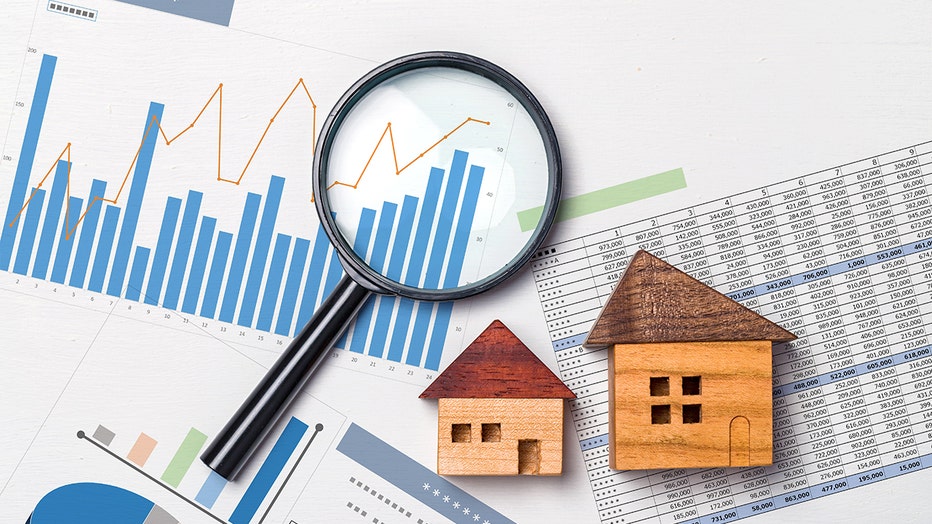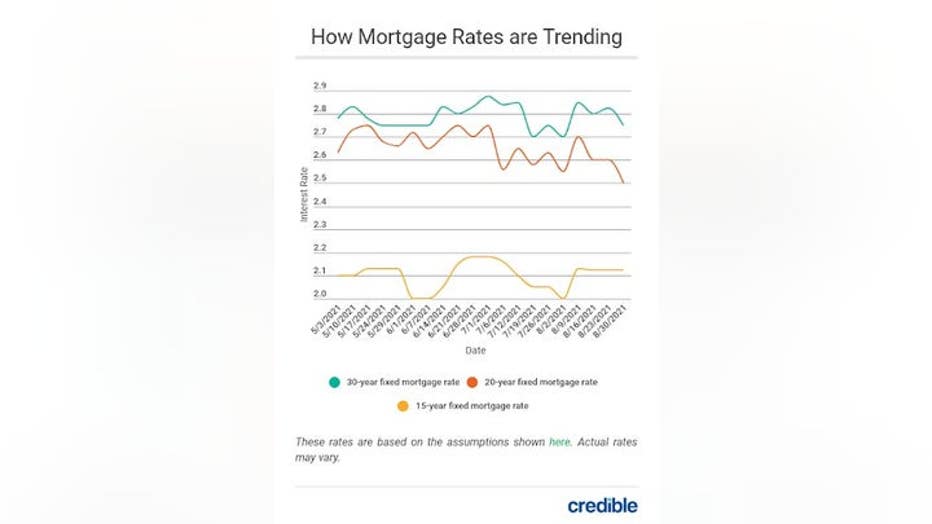20-year mortgage rates plummet to 6-month low | Sept. 10, 2021
Our goal here at Credible Operations, Inc., NMLS Number 1681276, referred to as "Credible" below, is to give you the tools and confidence you need to improve your finances. Although we do promote products from our partner lenders, all opinions are our own.

Check out the mortgage rates for Sept. 10, 2021, which are trending down from yesterday. (iStock)
Based on data compiled by Credible, mortgage rates have mostly fallen since yesterday.
- 30-year fixed mortgage rates: 2.750%, down from 2.875%, -0.125
- 20-year fixed mortgage rates: 2.375%, down from 2.500%, -0.125
- 15-year fixed mortgage rates: 2.000%, down from 2.125%, -0.125
- 10-year fixed mortgage rates: 2.000%, unchanged
Rates last updated on Sept. 10, 2021. These rates are based on the assumptions shown here. Actual rates may vary.
What this means: Mortgage rates for all terms close out the week at or near record lows, but the 20-year term is the standout bargain. As just 2.375% — the lowest this term has been since February — homebuyers can save significantly on interest while keeping their monthly mortgage payment manageable. Mortgage rates overall promise significant interest savings — the average mortgage interest rate dropped to 2.281% today, the lowest since Aug. 4.
To find the best mortgage rate, start by using Credible, which can show you current mortgage and refinance rates:
Browse rates from multiple lenders so you can make an informed decision about your home loan.
Credible, a personal finance marketplace, has 4,500 Trustpilot reviews with an average star rating of 4.7 (out of a possible 5.0).
Looking at today’s mortgage refinance rates
Today’s 20-year mortgage refinance rates sank to a record low of 2.375% — rates for this term have only been this low one other time, in July. Homeowners looking to refinance should act quickly to lock in this low rate, which could allow them to keep their monthly payment manageable while seeing significant interest savings. If you’re considering refinancing an existing home, check out what refinance rates look like:
- 30-year fixed-rate refinance: 2.750%, unchanged
- 20-year fixed-rate refinance: 2.375%, down from 2.500%, -0.125
- 15-year fixed-rate refinance: 2.000%, unchanged
- 10-year fixed-rate refinance: 2.000%, unchanged
Rates last updated on Sept. 10, 2021. These rates are based on the assumptions shown here. Actual rates may vary.
A site like Credible can be a big help when you’re ready to compare mortgage refinance loans. Credible lets you see prequalified rates for conventional mortgages from multiple lenders all within a few minutes. Visit Credible today to get started.
Credible has earned a 4.7 star rating (out of a possible 5.0) on Trustpilot and more than 4,500 reviews from customers who have safely compared prequalified rates.
How much can I borrow for a mortgage?
It’s critical to have an idea of how much you can afford to borrow for a mortgage before you begin home shopping or make an offer on a house.
Generally, the 28/36 rule is a good measure of how much you can afford to borrow without strapping your finances. The rule states that your mortgage payment, including taxes and insurance, shouldn’t be more than 28% of your gross monthly income. And all your debts, including your mortgage and other monthly expenses like car and student loan payments, shouldn’t exceed 36% of your gross monthly income.
For example, if your gross monthly income is $6,250 (annual salary of $75,000), you should be able to afford a monthly payment of $1,750. And your total monthly debt load shouldn’t exceed $2,250.
A general rule of thumb is that you shouldn’t take out a mortgage that’s two to two and half times your gross annual income. So in the above scenario, the maximum you should borrow to buy a house would be $187,500.
Ultimately, lenders determine how much you can afford to borrow by weighing your income, debt, assets, credit, and other financial factors.
Current mortgage rates
Average mortgage interest rates sank to 2.281% today — the lowest since Aug. 4.
Current 30-year mortgage rates
The current interest rate for a 30-year fixed-rate mortgage is 2.750%. This is down from yesterday. Thirty years is the most common repayment term for mortgages because 30-year mortgages typically give you a lower monthly payment. But they also typically come with higher interest rates, meaning you’ll ultimately pay more in interest over the life of the loan.
Current 20-year mortgage rates
The current interest rate for a 20-year fixed-rate mortgage is 2.375%. This is down from yesterday. Shortening your repayment term by just 10 years can mean you’ll get a lower interest rate — and pay less in total interest over the life of the loan.
Current 15-year mortgage rates
The current interest rate for a 15-year fixed-rate mortgage is 2.000%. This is down from yesterday. Fifteen-year mortgages are the second most-common mortgage term. A 15-year mortgage may help you get a lower rate than a 30-year term — and pay less interest over the life of the loan — while keeping monthly payments manageable.
Current 10-year mortgage rates
The current interest rate for a 10-year fixed-rate mortgage is 2.000%. This is the same as yesterday. Although less common than 30-year and 15-year mortgages, a 10-year fixed rate mortgage typically gives you lower interest rates and lifetime interest costs, but a higher monthly mortgage payment.
You can explore your mortgage options in minutes by visiting Credible to compare current rates from various lenders who offer mortgage refinancing as well as home loans. Check out Credible and get prequalified today, and take a look at today’s refinance rates through the link below.
Thousands of Trustpilot reviewers rate Credible "excellent."
Rates last updated on Sept. 10, 2021. These rates are based on the assumptions shown here. Actual rates may vary.
How Credible mortgage rates are calculated
Changing economic conditions, central bank policy decisions, investor sentiment, and other factors influence the movement of mortgage rates. Credible average mortgage rates and mortgage refinance rates are calculated based on information provided by partner lenders who pay compensation to Credible.
The rates assume a borrower has a 740 credit score and is borrowing a conventional loan for a single-family home that will be their primary residence. The rates also assume no (or very low) discount points and a down payment of 20%.
Credible mortgage rates will only give you an idea of current average rates. The rate you receive can vary based on a number of factors.
How mortgage rates have changed
Today, mortgage rates are a mixed bag compared to this time last week.
- 30-year fixed mortgage rates: 2.750%, the same as last week
- 20-year fixed mortgage rates: 2.375%, down from 2.500% last week, -0.125
- 15-year fixed mortgage rates: 2.000%, down from 2.125% last week, -0.125
- 10-year fixed mortgage rates: 2.000%, the same as last week
Rates last updated on Sept. 10, 2021. These rates are based on the assumptions shown here. Actual rates may vary.

If you’re trying to find the right rate for your home mortgage or looking to refinance an existing home, consider using Credible. You can use Credible's free online tool to easily compare multiple lenders and see prequalified rates in just a few minutes.
With more than 4,500 reviews, Credible maintains an "excellent" Trustpilot score.
How does the Federal Reserve affect mortgage rates?
The Federal Reserve System — or "The Fed," as it’s commonly called — is the United States’ central bank. It’s tasked with taking steps to keep the economy safe, stable, and flexible. Consequently, the Fed controls the U.S. money supply and short-term interest rates, and sets the Fed funds rate, which is the rate that banks apply when borrowing from each other overnight.
But the Fed doesn’t actually set mortgage rates. Rather, multiple things the Fed does influence mortgage rates. For example, while mortgage rates don’t mirror the Fed funds rate, they do tend to follow it. If that rate rises, mortgage rates typically rise in tandem.
The Fed also buys and sells mortgage-backed securities, or MBS — a package of similar loans that a major mortgage investor buys and then resells to investors in the bond market. When the Fed buys a lot of mortgage-backed securities, it creates demand in the market, and lenders can make money even if they offer lower mortgage rates. So rates tend to be lower when the Fed is doing a lot of buying.
When the Fed buys fewer MBS, demand falls and rates will likely rise. Similarly, when the Fed raises the Fed fund rate, mortgage rates will also increase.
Looking to lower your home insurance rate?
A home insurance policy can help cover unexpected costs you may incur during home ownership, such as structural damage and destruction or stolen personal property. Coverage can vary widely among insurers, so it’s wise to shop around and compare policy quotes.
Credible is partnered with a home insurance broker. If you're looking for a better rate on home insurance and are considering switching providers, consider using an online broker. You can compare quotes from top-rated insurance carriers in your area — it's fast, easy, and the whole process can be completed entirely online.
Have a finance-related question, but don't know who to ask? Email The Credible Money Expert at moneyexpert@credible.com and your question might be answered by Credible in our Money Expert column.
As a Credible authority on mortgages and personal finance, Chris Jennings has covered topics that include mortgage loans, mortgage refinancing, and more. He’s been an editor and editorial assistant in the online personal finance space for four years. His work has been featured by MSN, AOL, Yahoo Finance, and more.

